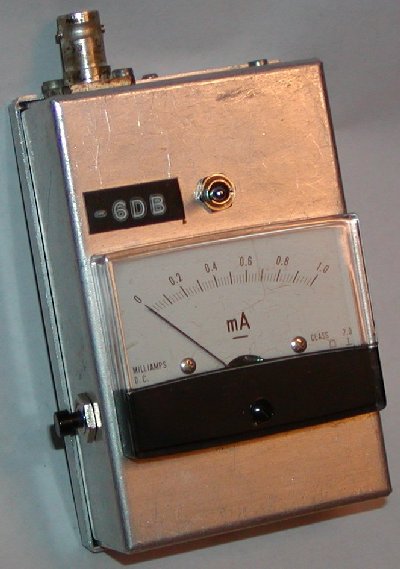 and the
HB9CV and attenuator are no longer any use … what next ?
and the
HB9CV and attenuator are no longer any use … what next ?
How to construct a “Sniffer” for 2m DF by Denis G3UVR
(From WADARC Newsletter 3rd May 2003)
Last time, we discussed making a good switched attenuator so
when you have taken bearings and arrived in an area of high signal strength you
can switch in up to around 30db of attenuation and continue to take important
bearings to get even closer. Well now we’ve arrived within 100 meters and the
HB9CV and attenuator are no longer any use … what next ?
and the
HB9CV and attenuator are no longer any use … what next ?
Now is the time to change over to a “Sniffer” and this one is designed to help you DF the fox from within 100 meters.
Construction of the “Sniffer”
1 It’s Suitable for DF at 144MHz within 100 meters of target
2 Battery Operated
3 Could be made from junk box parts
4 No special parts or PCB required
5 Cost approx. £7.50 if parts be bought in
The unit described is built in a stock aluminium box 102mm x 67mm x 36mm and powered by a PP3 9 volt battery that consumes seven milliamps when switched on so the battery lasts almost forever. A BNC RF input socket is used to connect up the sense antenna, usually a HB9CV. The RF circuit is built dead bug style on PCB 63mm x 31mm, and the DC amplifier constructed on Vero board by 12 holes point one pitch.

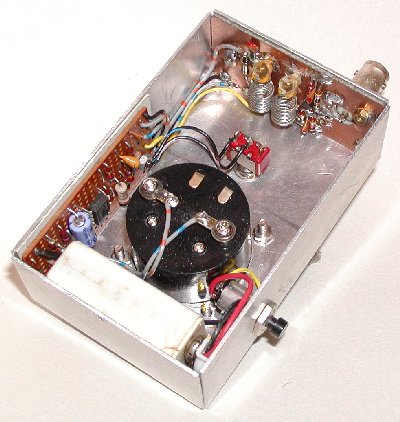 Parts Required
Parts Required
2 x 2-10pf trimmers
(RS 125-957 or 125-648)
2 x 1000pf feed through caps
2 x 1000pf wire end caps
1 x 10uf and 1uf 16 volt caps
LM301 ic, Germanium Diode, 1N4148 diode and 3SK88 Mosfet
Resistors 47 ohm, 220 ohm,
2 x 1k0 ohms, 2k7 ohms,
2 x 8k2 ohms, 12k ohms,
15k ohms, 100k ohms and 2m2 ohms
Meter One Milliamp FSD. 18 SWG wire for coils. 6 turns 6mm inside diameter.
The RF part was the third option. My first idea was to use a
passive front end consisting of just the tuned coils to give some rejection to
out of band signals driving the amplifier, but this was too insensitive unless
very close to the target. My second used a preamp to drive the amplifier with an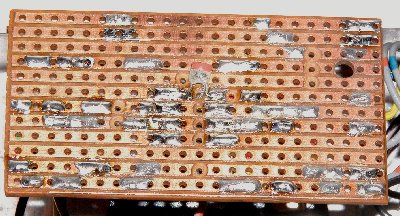 additional tuned circuit in the gate of the 3SK88, but this was too sensitive
picking up RF from hi power PMR sites if they were close by. The final
arrangement substituted the input tuning on the gate for a simple 47 ohm
resistor. This is what I have used for 2 meter DF’s for the last few years.
additional tuned circuit in the gate of the 3SK88, but this was too sensitive
picking up RF from hi power PMR sites if they were close by. The final
arrangement substituted the input tuning on the gate for a simple 47 ohm
resistor. This is what I have used for 2 meter DF’s for the last few years.
One small mod I did a couple of years ago was to fit a switch to reduce the gain of the amplifier. In most cases this avoided the use of the external attenuator. It just connects a 1 meg resistor in parallel with the 2m2 feedback resistor. Another idea would be to use say a 100k in series with a 2m2 variable to adjust the gain. If I ever get round to building the Mk4 version I would build a stepped attenuator ahead of the 3SK88 into the same box and illuminate the meter or use an LED display to improve visual reading in low light levels.
Built as described, the unit can produce a meter reading from
5 watts of RF from 100 meters away and yet is sensitive enough to read on low
power, unmanned foxes of 50 milliwatts at about 5 meters distant. Some
experienced foxes use higher power to try and swamp receiving equipment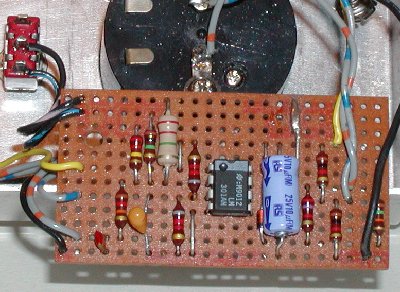 . I
found that using the 30db stepped attenuator previously described ahead of this
sniffer still kept the meter reading on the scale. The DC amplifier board is not
critical except for the value of the resistor in between the 1N4148 and the
meter. Too large a value the meter failed to reach FSD and with too small a
value you bend the meter needle round the end stop .. literally. 15k parallel
with 2k7 produced a nice
. I
found that using the 30db stepped attenuator previously described ahead of this
sniffer still kept the meter reading on the scale. The DC amplifier board is not
critical except for the value of the resistor in between the 1N4148 and the
meter. Too large a value the meter failed to reach FSD and with too small a
value you bend the meter needle round the end stop .. literally. 15k parallel
with 2k7 produced a nice
response up to FSD when the circuit would current limit avoiding damage to the meter. You can see this 15k having been added at the edge of the board after straightening my meter needle ! Another addition at a later date was to add a compensation capacitor of 47pf on the underside of the board between pin 1 and 8 of the LM301. This is shown on data sheets for the device.
My thanks again to Colin G3RLA who took the photo’s Denis G3UVR
Higher resolution pictures will be available together with the article very soon on the Club Website - www.wadarc.com This concludes two excellent articles by Denis which we hope will encourage members to both come and join in our Club Fox Hunting activities but also enjoy the satisfaction of using equipment they have built themselves.
Thank you Denis for a great contribution. Neil G4OAR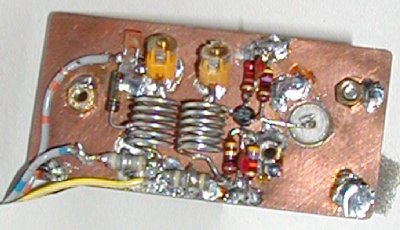
Return to Technical Articles Menu